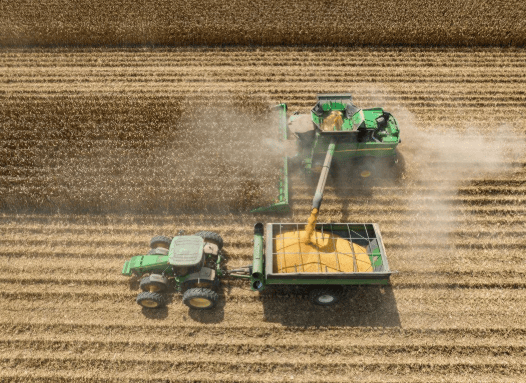Facing mounting pressure from America’s farm belt, President Donald Trump is preparing a multi-billion-dollar bailout aimed at rescuing U.S. farmers hit hard by his administration’s ongoing trade war and rising production costs.
Sources familiar with the discussions say the White House is finalizing a $10 billion to $14 billion aid package designed to provide direct relief to farmers suffering from tariffs, foreign retaliation, and falling commodity prices. The proposal underscores the growing strain within the agriculture sector as Trump’s second term enters its second year.
U.S. Farmers Grapple With Rising Costs and Shrinking Markets
According to the U.S. Department of Agriculture (USDA), total farm production expenses are expected to climb to $467.4 billion in 2025, up $12 billion from last year. Meanwhile, farm bankruptcies have surged to their highest level since 2021, reflecting the combined impact of global trade tensions, labor shortages, and lower commodity prices.
Trump’s trade policies — including tariffs on Chinese imports and stricter immigration enforcement — have contributed to these challenges. Retaliatory tariffs from China and other countries have slashed demand for U.S. exports, while tighter immigration rules have led to labor shortages across the agricultural workforce.
“There’s no doubt the farm economy is under significant stress,” Agriculture Secretary Brooke Rollins said Tuesday. “Soybeans are facing the greatest challenge, but corn, wheat, and cotton producers are also struggling.”
The Proposed Bailout: Tariff Revenues and Emergency Funds
To offset these losses, Trump’s team is considering two primary funding sources. The first is redirecting a portion of tariff revenues collected on imported goods toward direct payments to farmers. The second option involves tapping into the Emergency Commodity Assistance Program (ECAP), a USDA-managed fund previously used for farm relief efforts.
“We’ve made so much money on tariffs,” Trump wrote this week on social media, “that we are going to take a small portion of that money and help our farmers. I will never let our farmers down.”
White House officials say the final size of the package will depend on how much revenue is available from tariffs and the scale of losses across major agricultural sectors.
Beyond economic considerations, administration officials also frame the move as a national security priority, arguing that maintaining strong domestic food production is essential for the country’s long-term stability.
“We need to grow our own food,” one senior official said. “Dependence on foreign imports is a strategic risk. Protecting U.S. farmers protects America.”
Soybean Industry Faces Deepening Crisis
No segment has been hit harder by the trade conflict than the U.S. soybean industry, which generated more than $24 billion in exports in 2024. Nearly half of that total went to China, once the top buyer of U.S. soybeans.
That market has now all but collapsed. Since May, China has stopped importing U.S. soybeans, imposing a 20% tariff in retaliation for U.S. trade measures. Chinese buyers have instead turned to Brazil and Argentina, both of which have increased their soybean production and strengthened trade ties with Beijing.
The timing could not be worse for American farmers, many of whom are now harvesting a strong crop with no major buyer. “This is a crisis for soybean producers,” said American Soybean Association President Caleb Ragland. “We’ve been clear for months: the administration needs to secure a trade deal with China. Without it, our market share will continue to erode.”
Adding to the pressure, Washington recently approved a $20 billion credit line to Argentina’s central bank, helping stabilize the peso and indirectly boosting Argentina’s competitiveness in the global soybean market.
Farmers Demand Immediate Action
Across the Midwest, frustration is mounting as harvest season begins. “We can’t keep waiting,” one Indiana farmer told CNN. “Prices are down, input costs are up, and we’re losing markets we may never get back.”
Trump has publicly blamed China for the decline in soybean exports, accusing Beijing of using agricultural purchases as leverage in ongoing trade negotiations. He has pledged to make the issue a central topic in his upcoming meeting with Chinese President Xi Jinping next month in South Korea.
Behind the scenes, Agriculture Secretary Rollins is said to be pushing Treasury Secretary Scott Bessent and the White House economic team to finalize the relief plan quickly. Rollins called the idea of redirecting tariff revenue to support farmers “an elegant solution,” adding that the administration’s goal is to deliver aid “as swiftly as possible.”
Political Stakes and Economic Outlook
The agriculture bailout carries significant political weight. Rural voters were instrumental in Trump’s 2024 re-election victory, and the White House views the farm economy as critical to maintaining that support.
Economists warn, however, that while a $10–$14 billion bailout may provide short-term relief, it will not address the deeper structural issues facing U.S. agriculture. “Without a resolution to the trade conflict and a restoration of export markets, this aid is a temporary fix,” one analyst said.
In the long term, farmers will need stable trade agreements and diversified export partners to ensure sustainable growth.
What Comes Next
The final details of the bailout are expected to be announced in the coming weeks. If approved, it would rank among the largest federal farm aid packages in recent history, offering a financial lifeline to farmers facing one of the toughest years in more than a decade.
For now, America’s farmers are watching closely, hoping the administration’s promises translate into real relief — and that a broader trade resolution is not far behind.
Key Takeaways
Trump plans a $10–$14 billion bailout for U.S. farmers.
Funding may come from tariff revenue and the ECAP fund.
Soybean exports to China have fallen to zero due to retaliatory tariffs.
Farm costs are rising, with production expenses hitting $467 billion in 2025.
Bailout offers short-term relief, but trade negotiations remain critical.
Trusted by millions. Actually enjoyed by them too.
Most business news feels like homework. Morning Brew feels like a cheat sheet. Quick hits on business, tech, and finance—sharp enough to make sense, snappy enough to make you smile.
Try the newsletter for free and see why it’s the go-to for over 4 million professionals every morning.



